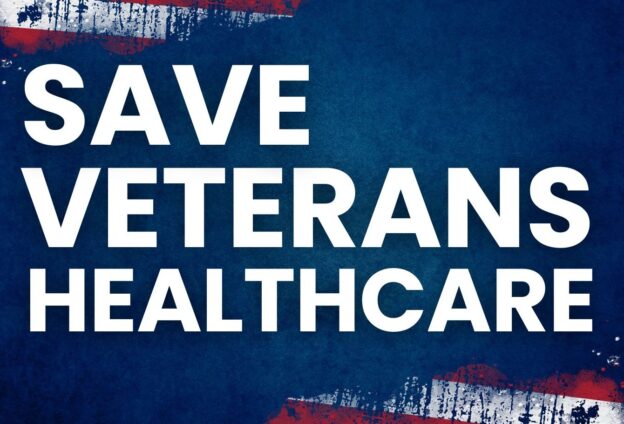FACT SHEET April 17, 2025
No Cuts to Veterans’ Healthcare and VA Staffing
- Currently 25-30% of VA employees are veterans. To date, 2,400 VA employees have already been fired. In total, 6,000 veterans have been let go from federal employment.
- To date there are 18 million living veterans, comprising 6.1% of the population. Nine million veterans received care visits at the VA in 2023. The VA System is the largest integrated healthcare network in the country. More than six million veterans have service-related disabilities.
- Cuts to VA healthcare services for veterans have already occurred despite assurances to the contrary by the Secretary of Veterans Affairs Doug Collins.
- The recent freeze on hiring and “return-to office” mandate adversely impacted the Veterans’ Crisis Line (SUICIDE HOTLINE) and eliminated the mental health tele-visit program. The Veterans’ Crisis Line takes 60,000 calls per month. There are 17.6 suicides by veterans per day, and this rate is increasing. Suicide is the second-leading cause of death for veterans under 45 years of age.
- The VA was a leader in tele-health care until these services were completely eliminated for veterans who live distant from a VA medical center. This directly impacts veterans living in rural areas.
- Projected cuts will also affect management of medical supplies, appointments and transportation.
- In 2025, the Secretary of Veterans Affairs attempted to cancel 875 contracts. These contracts included mission-critical items such as sterilizing equipment and maintenance of generators, boilers and scanning machines. These cuts were later “walked back” because the services were critical to the VA medical centers.
- The Office of the Inspector General completed its annual audit of the VA in 2024. The August 2024 Report revealed a severe shortage of employees in 98% of VA medical centers. This means 137 of 139 VA medical centers nationwide had staffing shortages in at least one area, particularly doctors, nurses, psychologists and custodians.
- This audit identified approximately 66,000 job vacancies at the VA in healthcare. The staff shortages cause long wait times for visits and an inability to accept new patients.
- The VA is also losing funds for research. VA research addresses issues including substance abuse, mental health, cancer (lung cancer, head and neck tumors), cardiovascular disease and war-related injuries such as spinal cord and brain trauma.
- The PACT Act (Sergeant First Class Heath Robinson Honoring our Promise to Address Comprehensive Toxins Act) in 2022 extended healthcare benefits for veterans exposed to toxic burn pits.
- The VA enrolled 400,000 veterans for benefits from 3/23 to 4/24, a 30% increase over the prior year.
- The Secretary of Veterans Affairs currently plans to cut an additional 15-17% of the VA workforce. This represents 80,000 to 83,000 current employees. Secretary Collins said the job cuts are “…to save money.”
Author: Michael Siebers, retired MD
William S. Middleton Memorial Veterans’ Hospital, 27 years’ service
Take Action Now! Please contact Elected Officials
- US Senators Tammy Baldwin and Ron Johnson
- Your Representative to the US House of Representatives |
- Spread the word
~ NO CUTS to Veterans’ Healthcare ~
National Projects of Veterans for Peace
“VFP’s Save Our VA (SOVA) National Campaign seeks justice for veterans and advocates for strengthening the Veterans Health Administration (VHA) for all veterans. The SOVA National Campaign consists of more than a thousand individual veteran and non-veteran supporters contacting their Members of Congress on VA health care issues. SOVA works in collaboration with our allies in the VA unions: the American Federation of Government Employees (AFGE), National Nurses United (NNU), and National Federation of Federal Employees (NFFE). “








Public health professionals have generally failed to work for the prevention of war, even though — like disease —war has negative impacts on health for both civilians and military personnel as well as detrimental impacts on infrastructure and the environment.
In a recent article, nine U.S. and Canadian public health scholars and thinkers directly confront “The Role of Public Health in the Prevention of War” — a role that has been tragically absent. Published in the June 2014 American Journal of Public Health, the writers pinpoint “militarism” as a root cause of the public health industry’s failure to take up the cause of preventing wars. Public health, they write, “has been more focused on the effects of war than on working toward the prevention of the fundamental causes of war.” The authors also define “militarism” in terms that are both familiar and chilling.
Worries roiling around the anti-Ebola virus effort, when compared with the prevention of war, might offer some insight into the way in which many Americans, including public health professionals, ignore the obvious when a new war is proposed, or an existing war is accepted, or a former war is discussed. As the outstanding, and overdue, AJPH article describes: “The United States launched 201 overseas military operations between the end of World War II and 2001, and since then, others, including Afghanistan and Iraq.”
Don’t the 190 million deaths “directly and indirectly related to war” during the 20th century represent a public health epidemic? Doesn’t the record-breaking war carnage of the past century qualify as a menace to public health?
If further proof is needed, consider this from the article: “Civilian war deaths constitute 85 percent to 90 percent of casualties caused by war, with about 10 civilians dying for every combatant killed in battle.”
Consider: “Ten percent to 20 percent of U.S. soldiers (of 1.8 million deployed since 2001) in the Iraq and Afghanistan wars have experienced a concussive event with long-term health implications.”
Consider: “Thirty percent of active duty women experience rape, and 5 percent multiple or gang rape. Female soldiers are more likely to be raped by a colleague than to be killed in combat.”
Consider: “More U.S. troops committed suicide last year than died in combat.”
The compilation and concise presentation of these staggering statistics by the article’s authors is exhaustively supported by 223 carefully researched references, by title, website, date and page.
To their credit, among other important breakthroughs the authors present a case for the prevention of war in fewer than 8,000 words. Details about authorship, led by W.H. Wiist of Northern Arizona University in Flagstaff, and references take up several more pages of this valid scholarly work, which is also very readable.
The writers follow a trail blazed when the American Public Health Association approved an official policy on the cessation of military recruiting in public schools. The APHA policy followed the 2002 No Child Left Behind Act, which gave military recruiters free access to public high schools along with the threat of funding cuts for noncompliance. According to the APHA policy: “Across the United States, recruiters from all branches of the military regularly enter every public high school to approach adolescents aged 14 through 18 years to persuade them to enlist in military service branches.” The vulnerability of minor-age children, and the disproportionate health consequences they face, compared to older soldiers, if they are recruited and sent to war is well documented. Action recommendations in the APHA policy include congressional repeal of public school collaboration with recruiters.
George Bush’s NCLB has been under justifiable scrutiny for its testing standards, while its enticement of adolescent children as potential combatants goes largely unnoticed. If parents, educators, churches, public health professionals, caregivers, and many other righteous people fail to intervene against the recruitment of minors in public schools, they embody the very definition of systemic militarism.
In three powerful paragraphs, the article dissects and defines militarism as extending a military mindset “into shaping the culture, politics, and economics of civilian life so that war and the preparation for war is normalized.”
Militarism “glorifies warriors, gives strong allegiance to the military as the ultimate guarantor of freedom and safety, and reveres military morals and ethics as being above criticism.” As a war-like, violence-seeking condition, the authors continue, “militarism has been called a ‘psychosocial disease,’ making it amenable to population-wide interventions.
“Thus, militarism warrants a priority focus for public health’s efforts to prevent war, including emphasis in public health curricula, research, and advocacy.”
Militarism’s profound effects on the economy, politics and corporate profits are noted, as are the military’s shadow cast across research and development, education, civilian law enforcement, justice systems, the media, outer space, and other important segments of 21st-century life. The writers wisely selected the pervasive presence of militarism as offering “critical insight for the analysis of the causes of war, the effects of war on health, and the influence of a culture of war on society and on the prospects for peace.”
They conclude: “Public health practitioners and academics have an obligation to take a lead role in the prevention of war by addressing the fundamental causes in society that lead to war.”
With clear thinking and focused writing, the American Journal of Public Health article explains precisely why “war is not healthy for children and other living things,” as the Another Mother for Peace anti-war slogan pointed out nearly 50 years ago.
David Giffey, of Arena, is the editor of “Long Shadows: Veterans’ Paths to Peace.”